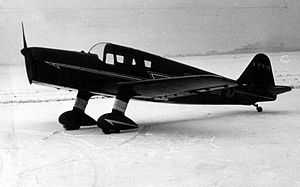RWD-19
| RWD-19 | |
|---|---|
 | |
| RWD-19 (1938) | |
| Role | Sports aircraft |
| National origin | Poland |
| Manufacturer | DWL |
| Designer | RWD bureau |
| First flight | October 1938 |
| Status | prototype |
| Number built | 1 |
|
| |
The RWD-19 was a Polish two-seat low-wing sports aircraft of 1938, constructed by the RWD bureau.
Development
The RWD-19 was designed in 1937-1938 in the RWD bureau. The chief designer was Jerzy Drzewiecki. Designer Tadeusz Chyliński designed the wing.[1] The aircraft was designed specially in order to beat world records of distance in light aircraft category, under influence of French Caudron sports aircraft.
Description
Mixed construction low-wing cantilever monoplane, conventional in layout, with a fixed landing gear and a closed cockpit. Steel framed fuselage, covered with canvas on a wooden frame, aluminum in front engine section. Three-part trapezoid wings with rounded tips, of wooden construction, two-spar, plywood (in front) and canvas covered, fitted with split flaps and slats. Conventional cantilever empennage, plywood (fins) and canvas (elevators and rudder) covered. Two seats in tandem, under a canopy, with a fixed panoramic windshield and small side windows. Behind the cockpit was a place for a baggage. Conventional fixed landing gear with a rear wheel, the main gear was in covers. 4-cylinder straight engine de Havilland Gipsy Major in front, driving a two-blade tractor wooden propeller Szomański of a fixed pitch. Fuel tanks 180 l in mid-wing section. Cruise fuel consumption 28 l/h.
Operational history
The prototype was built and first flown in October 1938 (registration SP-BPD). In winter it was evaluated by the Aviation Technical Institute in Poland. It was rather difficult to fly. There were no plans of serial production. The plan of beating a record was abandoned, because the German Arado Ar 79 had made it in the meantime. The sole aircraft was probably destroyed during air raids on the DWL factory after the outbreak of World War II.
Specifications
Data from Glass, A. (1977)
General characteristics
- Crew: 1, pilot
- Capacity: 1, passenger
- Length: 7.4 m ()
- Wingspan: 9.7 m ()
- Height: 2.1 m ()
- Wing area: 12 m² ()
- Empty weight: 580 kg ()
- Loaded weight: 900 kg ()
- Useful load: 320 kg ()
- Powerplant: 1 × de Havilland Gipsy Major 4-cylinder air-cooled inverted straight engine, 130 hp ()
Performance
- Maximum speed: 258 km/h
- Cruise speed: 230 km/h
- Stall speed: 72 km/h ()
- Range: 1300 km ()
- Service ceiling: 5,000 m ()
- Rate of climb: 4.6 m/s ()
- Wing loading: 75 kg/m² ()
See also
- Aircraft of comparable role, configuration and era
Notes
- ↑ Andrzej Glass (2003). Słownik biograficzny techników polskich, SBTP: Warsaw, p. 24: fragment of its entry about Tadeusz Chyliński: (Polish: W 1937 r. podjął prace w Doświadczalnych Warsztatach Lotniczych (RWD) jako konstr., jednocześnie kontynuowal studia. Pracował przy dok. seryjnej samolotu obserwacyjnego RWD 14 Czapla, następnie zaprojektował plat samolotu zawodniczego RWD-19, kadlub samolotu dyspozycyjnego RWD 18, łoże silnika do samolotu szk. RWD 23 i dźwigar płata samolotu myśliwskiego RWD 25. W l. 1933-38 byl czl. Sekcji Lotniczej Kola Mechaników Stud. PW.)
References
- Andrzej Glass: "Polskie konstrukcje lotnicze 1893-1939" (Polish aviation constructions 1893-1939), WKiŁ, Warsaw 1977, p. 327-328 (Polish)
External links
| Wikimedia Commons has media related to RWD-19. |
| ||||||
| ||||||||||||||||||||||